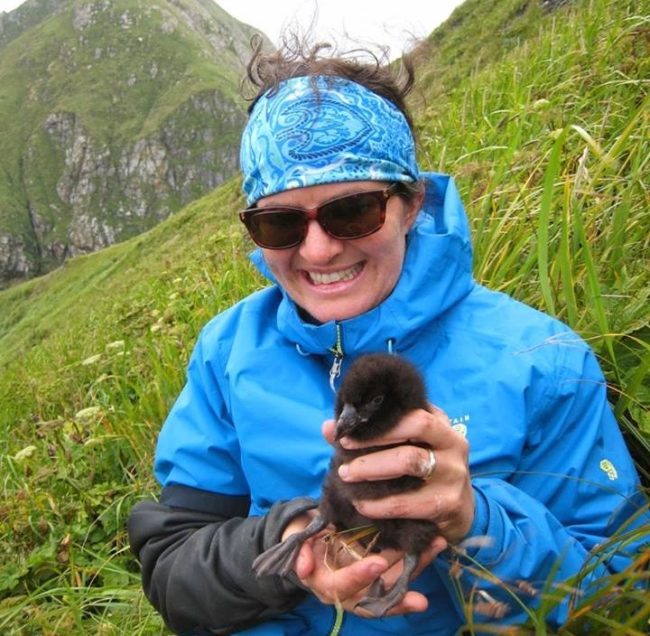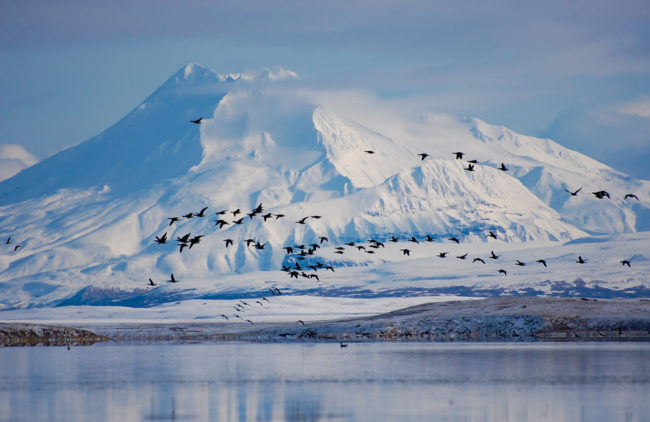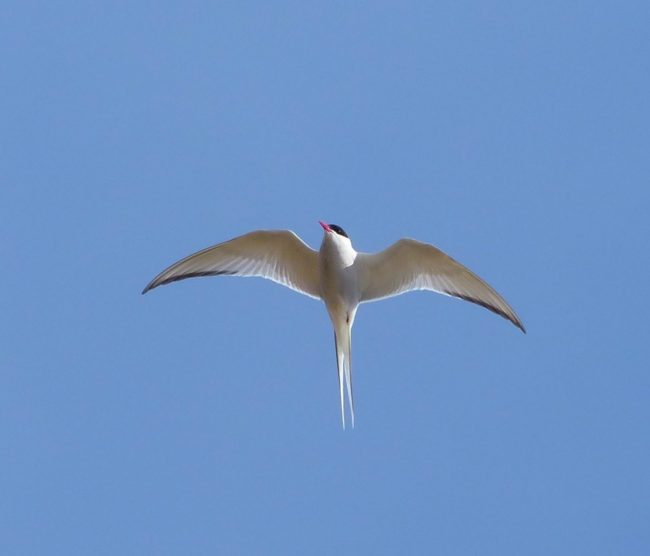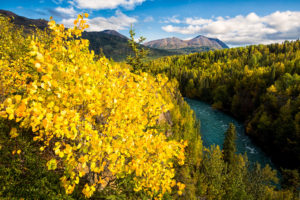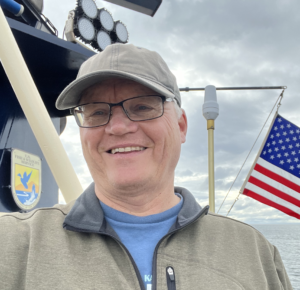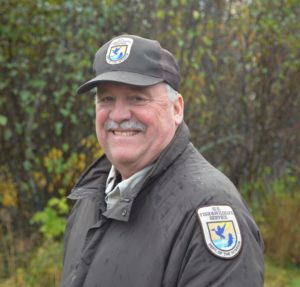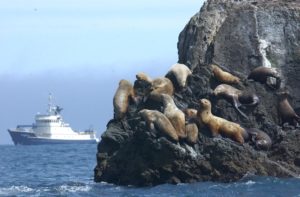This presentation was recorded in Homer, AK on Tuesday, February 18, 2025
Homer – Heather Renner in person at the Alaska Maritime National Wildlife Refuge Visitor Center, 95 Sterliing Hwy. Reception follows talk.
Soldotna – Watch Party at Kenai National Wildlife Refuge Visitor Center, Ski Hill Road
Anchorage – Watch Party at BP Energy Center, Spruce/Willow Room 1014 Energy Ct.
And Around the Country on Zoom
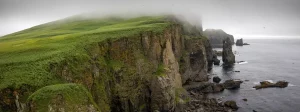
Sea cliffs and remote islands of the Alaska Maritime National Wildlife Refuge provide ideal nesting sites, protected from terrestrial predators and close to the ocean food source. Aiktak Island in the Semidi Islands is one of the annual monitoring sites of the refuge. PC Ian Shive
As early as summer 2015, Refuge biologists could tell something was amiss at common murre breeding colonies in Alaska. Murres were not showing up to breed like they have year in and year out. And then, the bodies started washing up on the beaches. In winter 2015 – 2016, half of Alaska’s common murre population, 4 million birds, died in the largest single species die-off for any bird or mammal species in recorded history. And they haven’t recovered yet. Hear from Heather Renner, Supervisory Biologist of the Alaska Maritime Refuge, on the refuge’s work to document the scope of this unprecedented tragedy.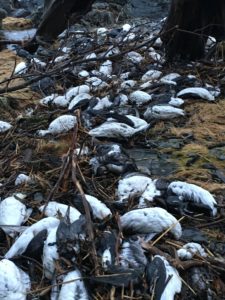 When birds die at sea, only a small percentage of the carcasses washes up on shore. What did it really mean in terms of total bird death that 62,000 carcasses were recovered up and down the coast from California to the Bering Sea? Breeding colony counts were needed to give a clearer picture. Unfortunately, for a few years after the die-off, murres didn’t breed successfully, so biologists couldn’t be sure how many had died and how many just weren’t returning to the colonies to breed. When breeding returned to “normal”, biologists learned the true scope of the die-off. Heather is one of six coauthors of a paper published in Science in December of 2024 that caused a considerable stir over the magnitude of the tragedy, the lack of recovery seven years later and the reason – a heat wave in the ocean.
When birds die at sea, only a small percentage of the carcasses washes up on shore. What did it really mean in terms of total bird death that 62,000 carcasses were recovered up and down the coast from California to the Bering Sea? Breeding colony counts were needed to give a clearer picture. Unfortunately, for a few years after the die-off, murres didn’t breed successfully, so biologists couldn’t be sure how many had died and how many just weren’t returning to the colonies to breed. When breeding returned to “normal”, biologists learned the true scope of the die-off. Heather is one of six coauthors of a paper published in Science in December of 2024 that caused a considerable stir over the magnitude of the tragedy, the lack of recovery seven years later and the reason – a heat wave in the ocean.
The refuge where much of this drama played out, the Alaska Maritime National Wildlife Refuge, is an unusual and unusually remote refuge of 2500 islands, headlands and rocks stretched across more than 1000 miles of Alaska’s coastline. It is one of the world’s premiere seabird refuges, with 40 million nesting seabirds. Heather’s team includes biologists working in groups of two to three in field camps on uninhabited islands scattered along the coast. This group of dedicated scientists has been documenting since the 1970’s the status of seabirds, their numbers and breeding success; it was these data that allowed firm conclusions as to the extent of this tragedy. Data used in this analysis spanned two huge marine ecosystems, the Gulf of Alaska and the Bering Sea. They also included seabird monitoring data collected on Togiak and Alaska Peninsula/Becharof national wildlife refuges, as well as data collected by Alaska Department of Fish and Game (Round Island) and Middleton Island. Long-term ecological datasets like this are incredibly rare and are urgently needed to understand which species are most vulnerable in our changing ocean.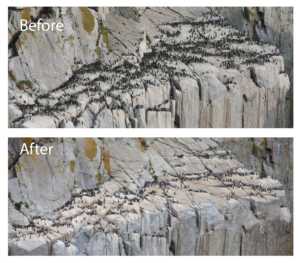 The before photo was taken in 2014 pre die-off and the post die-off photo was taken in 2021, six years after the event. South Island in the Semidi Islands.
The before photo was taken in 2014 pre die-off and the post die-off photo was taken in 2021, six years after the event. South Island in the Semidi Islands.
Read More:
Monitoring the Common Murre: Mass Mortality in Coastal Alaska
Four Million Murres Missing: How long-term monitoring revealed an unprecedented wildlife die-off in Alaska
Biography
Seabirds, the Alaska Maritime Refuge and Alaska are part of who Heather Renner is. She is a life- long Alaskan who has worked for the Refuge for 25 years. She began her career at just 15 working in the Fish and Wildlife Service Regional office fisheries program. From there she worked her way up in other Alaskan Refuges – Alaska Peninsula/Becharof, YukonDelta, Togiak and Kenai – from a seasonal bio tech working in field camps to now supervisor of one of the most respected biological programs in the U.S. Fish and Wildlife Service. Heather even met her husband while he was completing his doctoral research in a field camp on Buldir Island. It has been her love for wild and remote places that drew her to Alaska’s refuges and inspired her to stay for so long.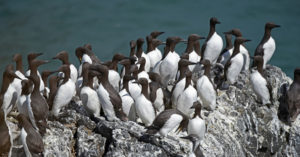
Common murres nest in huge colonies laying their eggs right on the bare rock.
Heather said seabirds interested her because “they thrive in places that might seem miserable to people.” She also said she was excited about the science that could be done with seabirds and the questions that could be answered with 50 years of data. Much of Heather’s focus has been coordinating long-term monitoring datasets of seabirds and using those data to address scientific questions about both seabird conservation and ecosystem change. She is also interested in methods development for monitoring techniques. Heather has a BA in Biology from Colorado College, and a MS in Wildlife Management from Cornell University. She lives in Homer with her family and in her spare time, she enjoys outdoor activities like hiking, trail running and cross-country skiing.
